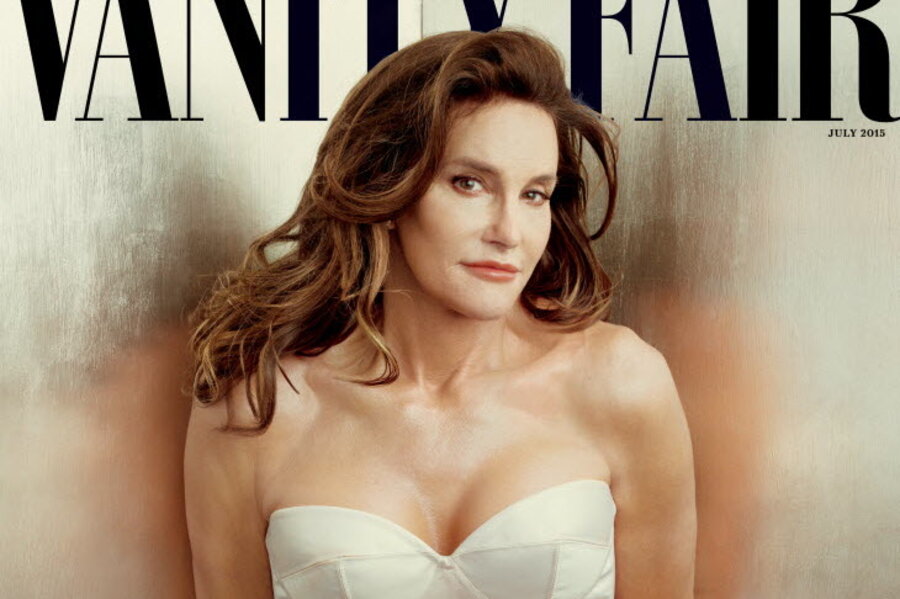What does being a woman mean? Caitlyn Jenner’s emergence rekindles debate.
Loading...
| New York
When Caitlyn Jenner unveiled her full transgender identity in a glossy, Kardashian-esque Vanity Fair spread last week, some progressive feminist activists said they winced.
The former Olympic gold medalist, dubbed the “world’s greatest athlete” in 1976 after winning the decathlon as a male, presented her identity as a transgender woman in a way that some found all too familiar: a collection of sultry, demure, and hypersexualized images.
The idea that a biological male or female can assume the identity of the opposite gender is something that many religious conservatives have voiced their opposition to for some time. But some radical feminists have objections, too – saying that males who transition to females can hardly embody the unique experiences, both physically and culturally, that constitute being an authentic female.
What it means to be female means has in fact been an angry debate within some feminist circles, scholars say. That debate dates back to the “second wave” of feminism in the 1960s and ’70s, when some thinkers and activists refused to include transgender women as part of their movement for women’s liberation.
After the unprecedented visibility of transgender people over the past year, including Ms. Jenner’s carefully scripted emergence as a glamorous woman in her 60s, the debate has been rekindled in some progressive circles. The vitriol between the factions has erupted on Twitter under the hashtag #terf, the often-pejorative acronym for “trans exclusionary radical feminist.”
“What’s different in this instance, is this conversation is tied to ideas of authentication: ‘What is authentically a woman?’ ” says Cristan Williams, a trans historian and editor at the Houston-based TransAdvocate.com. “There is this idea, this notion that there is this one specific experience that all – all – non-transgender women must have, and that transgender women can never have.”
“So [exclusionary feminists] couch it in terms of being born a woman – that there is one essence of woman somewhere out there that’s either experiential, or somehow physical, or spiritual,” Ms. Williams continues.
In an interview with Diane Sawyer in April, Jenner talked of having “the soul of a female” and said that “my brain is much more female than it is male.”
This past weekend, Elinor Burkett, a documentary filmmaker and former professor of women’s studies, challenged the idea that Jenner – who lived for more than 65 years as Bruce, a strong, athletic male with attending cultural privileges – could really understand what it means to be a woman. She contrasted the celebrations of Jenner’s current actions with the scorn heaped on former Harvard president and Obama administration official Lawrence Summers, who stepped down from his university position not long after raising the question of whether innate differences between males and females led to different abilities in math and science.
“For me and many women, feminist and otherwise, one of the difficult parts of witnessing and wanting to rally behind the movement for transgender rights is the language that a growing number of trans individuals insist on, the notions of femininity that they’re articulating, and their disregard for the fact that being a woman means having accrued certain experiences, endured certain indignities and relished certain courtesies in a culture that reacted to you as one,” she wrote in an opinion piece in The New York Times.
Some are arguing that the femininity that Jenner is exhibiting is precisely the kind of oppressive gender stereotyping that feminism has long tried to dismantle.
“These societally defined traits of sex do not define a sex,” wrote Libby Emmons and David Marcus in a piece on the conservative culture site “The Federalist” last week. “Feminists have been fighting for decades, since the suffragettes, to vocalize the non-feminineness of females. We can vote, we can fight, we can wear pants and flats, we can boss a whole room of employees without demurring. To allow the trans movement to objectify women is to accept the oppression of the female sex by the male sex, and to further accept male definitions of what it is to be female.”
In many ways, this is a valid critique of culture, says Williams, and perhaps even a valid analysis of ideas of gender. But it’s not really a critique of who transgender people are – since, like biological males and females, there is a wide-ranging diversity of how people express their notions of gender.
“I don’t take issue with a critique of this specific person, or this specific behavior,” Williams says. “As long as that critique is made of non-transgender women who engage in the exact same behavior.”
In fact, she says, there are trans women who are very traditionally “fem,” like Jenner, and trans women, like herself, who ride a motorcycle and everything in between. “Somehow, in some way, if I ride a Harley then I’m colonizing dyke culture,” she says of the lesbian subculture that she might be associated with – and accused of culturally appropriating as an outsider. “If I wear a dress, then I’m just a caricature of a woman.”
Behind these critiques, Williams and others see a familiar fear – “a fear that somehow, because trans people exist, because trans women exist, that is going to somehow take something intrinsic to their experience of being a woman, and somehow trivialize that, or defame it, or impugn it in some way that only trans people can do.”






